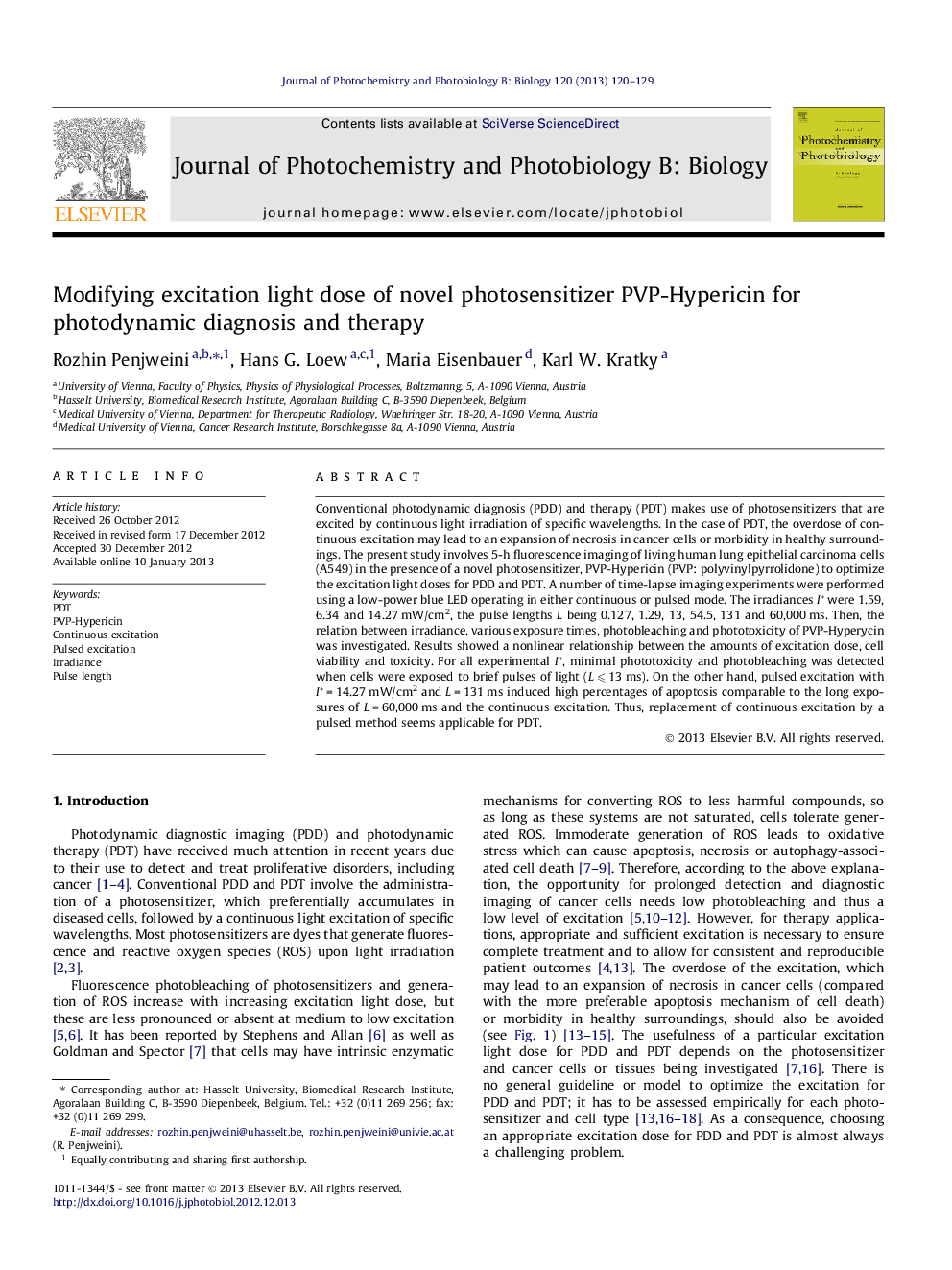| Article ID | Journal | Published Year | Pages | File Type |
|---|---|---|---|---|
| 30637 | Journal of Photochemistry and Photobiology B: Biology | 2013 | 10 Pages |
Conventional photodynamic diagnosis (PDD) and therapy (PDT) makes use of photosensitizers that are excited by continuous light irradiation of specific wavelengths. In the case of PDT, the overdose of continuous excitation may lead to an expansion of necrosis in cancer cells or morbidity in healthy surroundings. The present study involves 5-h fluorescence imaging of living human lung epithelial carcinoma cells (A549) in the presence of a novel photosensitizer, PVP-Hypericin (PVP: polyvinylpyrrolidone) to optimize the excitation light doses for PDD and PDT. A number of time-lapse imaging experiments were performed using a low-power blue LED operating in either continuous or pulsed mode. The irradiances I* were 1.59, 6.34 and 14.27 mW/cm2, the pulse lengths L being 0.127, 1.29, 13, 54.5, 131 and 60,000 ms. Then, the relation between irradiance, various exposure times, photobleaching and phototoxicity of PVP-Hyperycin was investigated. Results showed a nonlinear relationship between the amounts of excitation dose, cell viability and toxicity. For all experimental I*, minimal phototoxicity and photobleaching was detected when cells were exposed to brief pulses of light (L ⩽ 13 ms). On the other hand, pulsed excitation with I* = 14.27 mW/cm2 and L = 131 ms induced high percentages of apoptosis comparable to the long exposures of L = 60,000 ms and the continuous excitation. Thus, replacement of continuous excitation by a pulsed method seems applicable for PDT.
Graphical abstractTo achieve optimal diagnostic and therapeutic efficacy of PVP-Hypericin for photodynamic application, the applied excitation light dose has to be chosen appropriately. The overdose of the excitation may result in an expansion of necrosis in cancer cells as well as sizeable morbidity in healthy surroundings since photosensitizers also accumulate in non-cancer cells.In this paper, we introduced a standardized irradiation protocol when using 50 μM PVP-Hypericin for destruction of the A549 cancer cells. The experiments showed that irradiance, I∗, together with exposure time uniquely define the efficiency of the excitation in PDT. Furthermore, the nonlinear relationship between the amounts of excitation dose and the phototoxicity of PVP-Hypericin was specified.Bearing in mind side effects due to necrosis, our experiments suggest that appropriate pulsed excitation may replace continuous excitation in PDT. Pulsed irradiation with I∗ = 14.27 mW/cm2 together with L = 131 ms may be an effective alternative to continuous excitation of PVP-Hypericin. To our knowledge, optimizing the excitation light dose (both I∗ and exposure time) of PVP-Hypericin for PDT has not previously been studied. Therefore, the outcome of this study will be essential in defining optimal irradiance and exposure time in PDT of A549 cancer cells.Figure optionsDownload full-size imageDownload as PowerPoint slideHighlights► Optimization of excitation light dose (irradiance and exposure time). ► Introducing a standardized irradiation protocol when using 50 μM PVP-Hypericin for destruction of the A549 cancer cells.
